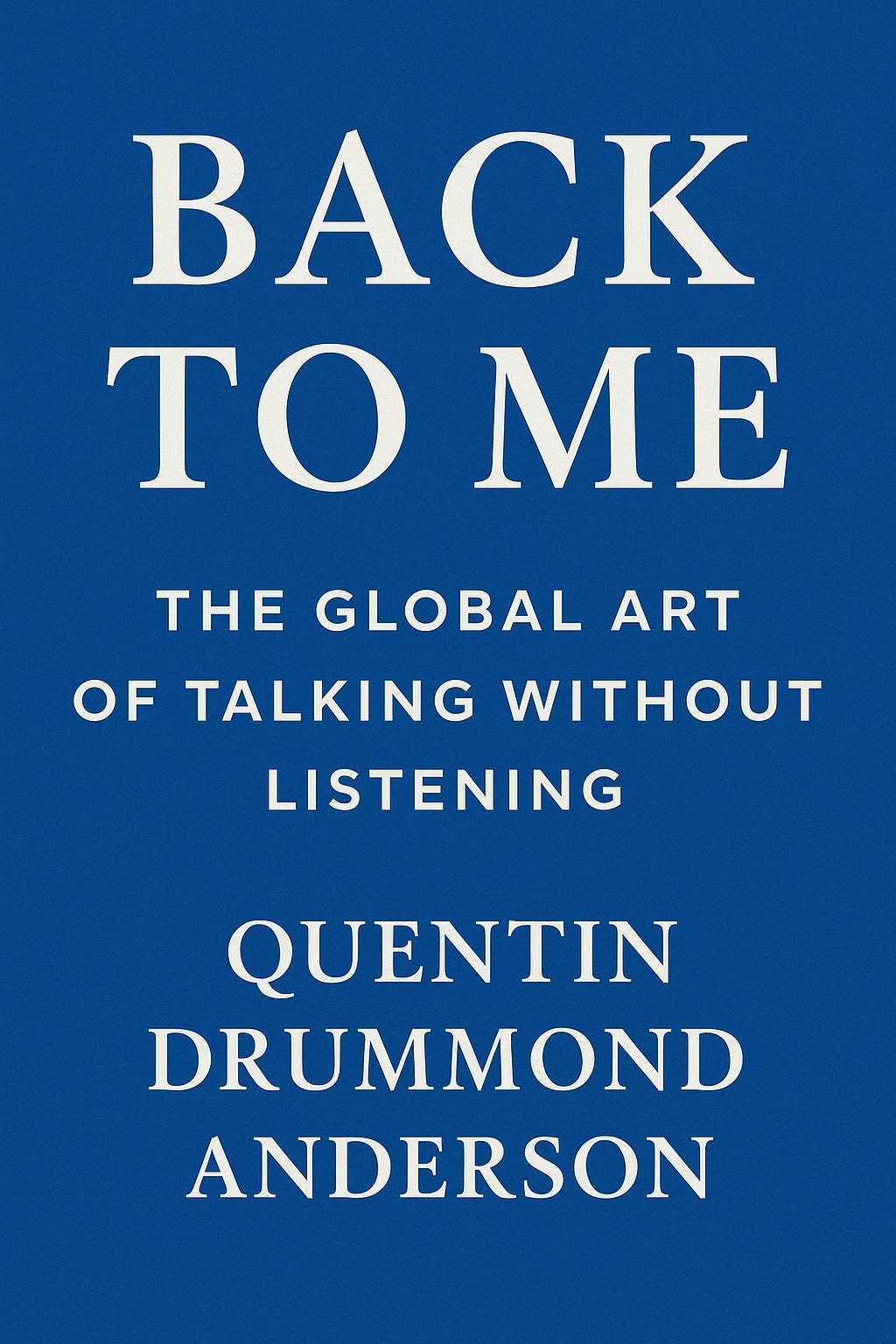by Ludo Stuart-Douglas The Writers Collective London November 2025
In a world where the volume of communication has never been higher, Back to Me: The Global Art of Talking Without Listening by Quentin Drummond Anderson arrives as both mirror and manifesto. It is, in equal measure, a cultural study, a global ethnography of speech, and a wry philosophical treatise on the decline of genuine listening. Scheduled for publication on 15th December, and now available for pre-order, the book dissects the conversational narcissism of our age with a blend of academic precision and social wit that feels at once deeply serious and refreshingly readable.
Anderson’s premise is simple but profound: humanity has mistaken communication for connection. Across cultures, classes, and platforms, we now perform dialogue rather than engage in it. Beneath the humour, the author is conducting a form of intellectual anthropology — mapping the manners, pauses, and power games of global conversation.
Below are 20 of the book’s most striking findings, insights, and “Andersonisms” — moments that crystallise its sharp blend of social observation and scholarship.
1. The Eleven-Second Rule
Anderson cites behavioural research suggesting that the average person interrupts within eleven seconds — a measurable symptom of what he calls “the conversational arms race.”
2. The Polite Ambush (United Kingdom)
British conversation has evolved into “a game of gentle intrusion.” The phrase “Sorry, but…” now functions as a linguistic shield — allowing speakers to interrupt while preserving the illusion of civility.
3. Interruptus Maximus
The author’s most memorable creation, Interruptus Maximus, describes the dominant personality of our time: a speaker who fears silence more than ignorance and sees dialogue as conquest.
4. The Monologue Society
Anderson defines modern communication as “two simultaneous broadcasts” — individuals exchanging sound rather than meaning.
5. Nordic Silence as Power
In Scandinavia, silence is not social failure but status. The person who pauses longest is perceived as wisest — an elegant inversion of Anglo-American norms.
6. Mediterranean Overlap
By contrast, Italian and Spanish discourse values simultaneous speech. “Overlap,” Anderson notes, “isn’t rudeness — it’s rhythm.”
7. American Affirmation
In the United States, listening has been replaced by affirmation: “That’s amazing!” functions as punctuation rather than comprehension.
8. Japanese Silence as Respect
In Japan, restraint signals respect. The unspoken becomes the highest form of communication — an idea Anderson links to Zen concepts of ma, the pause between actions.
9. French Duelism
French conversation, he observes, “is fencing with words.” Interruption signifies intellect, not insolence.
10. The Humblebrag Epidemic
Social media has institutionalised self-promotion disguised as modesty — “the ego in camouflage,” as Anderson calls it.
11. Aggressive Agreement
A distinctly modern pathology: interrupting not to contradict, but to echo — louder. “Consensus has become competitive,” he quips.
12. The Performance Society
Drawing on Goffman, Anderson argues that social media has completed the shift from conversation to theatre. “We no longer talk to be understood,” he writes. “We talk to be seen.”
13. Roman Roots of Eloquence
Tracing the Western obsession with oratory back to classical Rome, he suggests that listening has long been treated as the lesser art.
14. Verbal Inflation
In our hyper-connected world, ordinary opinions are now expressed in the language of moral crusades. “Every dinner party is a summit,” Anderson observes drily.
15. The Silent Strategists
History’s most effective negotiators, from Talleyrand to Kissinger, are those who mastered the pause. Silence, in diplomacy as in dialogue, is often the decisive gesture.
16. The Empathy Paradox
Gendered listening, Anderson notes, remains consistent worldwide: women are taught to affirm, men to perform — a tension that undercuts authentic empathy.
17. Humour as Social Weapon
Wit becomes the clever person’s form of self-defence — “truth wrapped in laughter travels further than sincerity shouted.”
18. The Conversational Narcissism Index
A tongue-in-cheek quiz within the book measures how quickly readers redirect any topic “back to me.” It’s both comic and uncomfortably revealing.
19. Listening as Transformation
Anderson’s central philosophical claim: “Hearing without being changed is merely waiting to speak.” True listening, he argues, is an act of surrender, not strategy.
20. The Final Whisper
The closing line — “When everyone shouts, wisdom whispers.” — is destined to become the book’s epigraphic signature.
A Global Dissertation with a Comic Pulse
What distinguishes Back to Me from the growing literature on communication theory is its global anthropology of manners. Anderson treats conversation not as etiquette but as evidence — a behavioural reflection of each society’s structure of power and emotion. His use of humour disarms the reader while reinforcing the scholarship beneath it. The book reads, at times, like a sociological study disguised as dinner-table comedy.
Yet it is not cynical. Anderson’s tone is urbane but generous. Beneath the satire runs a quiet optimism — a belief that listening, like courtesy, can still be revived. His conclusion feels less like admonition than invitation: a call to re-civilise the way we speak to one another.
In short, Back to Me is that rare cultural work — intellectually rigorous, globally observant, and genuinely funny. It belongs as comfortably on a university reading list as on a bedside table.
Published 15th December by The Writers Collective. Available now for pre-order on Amazon Kindle, hardcover, and audiobook.
A witty guide to the modern world’s oldest problem — how to stop talking and start understanding.
